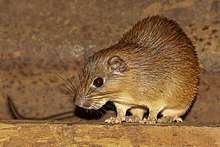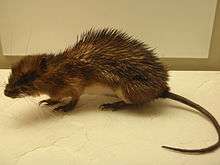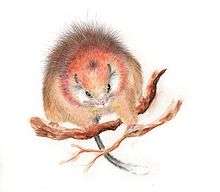Echimyidae
Echimyidae is the family[2] of neotropical spiny rats and their fossil relatives.[3] This is the most species-rich family of hystricognath rodents.[4] It is probably also the most ecologically diverse, with members ranging from fully arboreal to terrestrial to fossorial to semiaquatic habits.[4] They presently exist mainly in South America; three members of the family also range into Central America. Species of the extinct subfamily Heteropsomyinae formerly lived on Cuba, Hispaniola, and Puerto Rico in the Antilles,[3] probably until the arrival of Europeans.[4] Some authorities consider the nutria from southern and central South America to be a part of this family.
| Echimyidae | |
|---|---|
 | |
| Ferreira's spiny tree-rat, Mesomys hispidus | |
| Scientific classification | |
| Kingdom: | Animalia |
| Phylum: | Chordata |
| Class: | Mammalia |
| Order: | Rodentia |
| Suborder: | Hystricomorpha |
| Infraorder: | Hystricognathi |
| Parvorder: | Caviomorpha |
| Superfamily: | Octodontoidea |
| Family: | Echimyidae Gray, 1825 |
| Subfamilies and genera incertae sedis | |
|
Capromyinae | |




Characteristics
In general form, most spiny rats resemble rats, although they are more closely related to guinea pigs and chinchillas. Most species have stiff, pointed hairs, or spines, that presumably serve for protection from predators.
Many echimyids can break off their tails when attacked. This action may confuse predators long enough for the spiny rat to escape. Unlike the tails of some species of lizards, however, the tails of spiny rats do not regenerate. Therefore, the tactic can only be used once in an individual's lifetime.
Most spiny rats are rare and poorly known, but a few are extremely abundant. Various species are respectively terrestrial, arboreal, or fossorial. In general, the arboreal forms are most rat-like in appearance, whilst the burrowing species are more gopher-like, with stocky bodies and short tails. Most species do poorly in conditions of high heat and aridity and are restricted to regions with abundant water. They are almost exclusively herbivorous.
Systematics
The current taxonomic content of the family Echimyidae has been reshaped over time, and its organization into coherent units stems from two realizations. The first is that cladistic approaches applied to morphological characters showed that many traits used to define taxa were plesiomorphic or homoplastic. The second realization came from the advent of phylogenetic analyses of DNA sequence and protein sequence data with probability methods — maximum likelihood and Bayesian inference — leading to the identification of robust clades and the recognition of higher categorical ranks (see Phylogeny section).[5][6] The following table recapitulates and compares the taxonomic content of taxa recognized on molecular and traditional basis: the two families Capromyidae and Myocastoridae, the five subfamilies Echimyinae, Euryzygomatomyinae, Capromyinae, Dactylomyinae, Eumysopinae, and the four tribes Echimyini, Myocastorini, Capromyini, and Plagiodontini.
Extant genera
- Family Echimyidae - spiny rats
| Genus | Vernacular name | Molecular-based subfamily | Molecular-based tribe | Traditional systematics |
|---|---|---|---|---|
| Echimys | arboreal spiny rats | Echimyinae | Echimyini | Echimyinae |
| Phyllomys | Atlantic tree-rats | Echimyinae | Echimyini | Echimyinae |
| Makalata | — | Echimyinae | Echimyini | Echimyinae |
| Pattonomys | — | Echimyinae | Echimyini | Echimyinae |
| Toromys | giant tree-rat | Echimyinae | Echimyini | Echimyinae |
| Diplomys | — | Echimyinae | Echimyini | Echimyinae |
| Santamartamys | red-crested tree-rat | Echimyinae | Echimyini | Echimyinae |
| Isothrix | toros or brush-tailed rats | Echimyinae | Echimyini | Echimyinae |
| Dactylomys | bamboo rats | Echimyinae | Echimyini | Dactylomyinae |
| Olallamys | olalla rats | Echimyinae | Echimyini | Dactylomyinae |
| Kannabateomys | Atlantic bamboo rat | Echimyinae | Echimyini | Dactylomyinae |
| Lonchothrix | tuft-tailed spiny tree-rat | Echimyinae | Echimyini | Eumysopinae |
| Mesomys | spiny tree-rats | Echimyinae | Echimyini | Eumysopinae |
| Callistomys | painted tree-rat | Echimyinae | Myocastorini | Echimyinae |
| Myocastor | coypu | Echimyinae | Myocastorini | Myocastoridae |
| Thrichomys | punaré | Echimyinae | Myocastorini | Eumysopinae |
| Hoplomys | armored rat | Echimyinae | Myocastorini | Eumysopinae |
| Proechimys | spiny rats | Echimyinae | Myocastorini | Eumysopinae |
| Trinomys | Atlantic spiny rats | Euryzygomatomyinae | — | Eumysopinae |
| Euryzygomatomys | guiara | Euryzygomatomyinae | — | Eumysopinae |
| Clyomys | — | Euryzygomatomyinae | — | Eumysopinae |
| Carterodon | Owl's spiny rat | Incertae sedis | — | Eumysopinae |
| Plagiodontia | — | Capromyinae | Plagiodontini | Capromyidae |
| Geocapromys | — | Capromyinae | Capromyini | Capromyidae |
| Mesocapromys | — | Capromyinae | Capromyini | Capromyidae |
| Mysateles | — | Capromyinae | Capromyini | Capromyidae |
| Capromys | Desmarest's hutia | Capromyinae | Capromyini | Capromyidae |
Extinct genera
- Family Echimyidae - spiny rats
- †Cercomys
- †Maruchito
- †Paulacoutomys
- †Proclinodontomys
- †Willidewu
- Subfamily †Adelphomyinae
- †Adelphomys
- †Deseadomys
- †Paradelphomys
- †Stichomys
- †Xylechimys
- Subfamily †Heteropsomyinae - extinct West Indian echimyids
- †Boromys
- †Brotomys
- †Heteropsomys
- †Puertoricomys
- Subfamily Eumysopinae
- †Acarechimys
- †Chasichimys
- †Eumysops
- †Palaeoechimys
- †Pampamys
- †Pattersomys
- †Protacaremys
- †Protadelphomys
- †Sallamys
About Chaetomys
The bristle-spined rat, Chaetomys subspinosus, has sometimes been classified in Echimyidae,[4] although traditionally considered a member of the New World porcupine family Erethizontidae.[9] The classification with Echimyidae is supported by similarities in the cheek teeth structure.[10] Like all living caviomorphs except erethizontids, Chaetomys seems to lack posterior carotid foramina, and together with all echimyids and in contrast to all other caviomorphs, Chaetomys seems to retain the otherwise deciduous premolars (dP4).[11] Some of these characters have been, however, reinterpreted as evidence for affinities between Chaetomys and the Erethizontidae.[12] A molecular phylogeny based on the mitochondrial gene coding for cytochrome b combined to karyological evidence actually suggests Chaetomys is more closely related to the Erethizontidae than to the Echimyidae, although it branches as the sister group to the rest of the Erethizontidae.[13]
Phylogeny
The phylogenetic tree of the Echimyidae shows a major split between the subfamily Echimyinae and an assemblage containing the Euryzygomatomyinae, Carterodon, and the Capromyidae. The first major clade contains a majority of arboreal genera (e.g., Phyllomys, Dactylomys, and Mesomys), a few terrestrial taxa (e.g., Proechimys), and a subaquatic one (Myocastor). The second major clade includes fossorial genera (e.g., Euryzygomatomys or Carterodon), a terrestrial one (Trinomys), and members inhabiting the Caribbean islands (Capromyidae).
| Genus-level cladogram of the Echimyidae (including members of the family Capromyidae). | |||||||||||||||||||||||||||||||||||||||||||||||||||||||||||||||||||||||||||||||||||||||||||||||||||||||||||||||||||||||||||||||||||||||||||||||||||||||||||||||||
| |||||||||||||||||||||||||||||||||||||||||||||||||||||||||||||||||||||||||||||||||||||||||||||||||||||||||||||||||||||||||||||||||||||||||||||||||||||||||||||||||
| The cladogram has been reconstructed from mitochondrial and nuclear DNA characters.[14][15][16][17][18][19][20][21][5][6] The green bar shows the polyphyly of the arboreal taxa, due to closer affinities of Callistomys with Myocastorini rather than with Echimyini. The red bar shows the polyphyly of the fossorial taxa, due to closer affinities of Carterodon with Capromyidae rather than with Euryzygomatomyinae. |
References and notes
- Emmons, Louise Hickock (2005). "A revision of the genera of arboreal Echimyidae (Rodentia: Echimyidae, Echimyinae), with descriptions of two new genera". Mammalian Diversification: From Chromosomes to phylogeography (A Celebration of the Career of James L. Patton). 133. University of California Press. pp. 247–310. ISBN 9780520098534.
- Gray, J. E. (1825). "Outline of an attempt at the disposition of the Mammalia into tribes and families with a list of the genera apparently appertaining to each tribe". Annals of Philosophy. 10: 337–344.
- Woods, C.A.; Kilpatrick, C.W. (2005). "Family Echimyidae". In Wilson, D.E.; Reeder, D.M (eds.). Mammal Species of the World: A Taxonomic and Geographic Reference (3rd ed.). Johns Hopkins University Press. pp. 1575–1592. ISBN 978-0-8018-8221-0. OCLC 62265494.
- Myers, P. "Echimyidae: spiny rats". Animal Diversity Web. University of Michigan. Retrieved 2013-01-06.
- Fabre, Pierre-Henri; Patton, James L.; Leite, Yuri L. R. (2016). "Family Echimyidae (hutias, South American spiny-rats and coypu)". In Wilson, Don E.; Lacher, Thomas E. Jr; Mittermeier, Russell A. (eds.). Handbook of the Mammals of the World. Vol 6. Lagomorphs and Rodents I. Barcelona: Lynx Edicions. pp. 552–641. ISBN 978-84-941892-3-4.
- Fabre, Pierre-Henri; Upham, Nathan S.; Emmons, Louise H.; Justy, Fabienne; Leite, Yuri L. R.; Loss, Ana Carolina; Orlando, Ludovic; Tilak, Marie-Ka; Patterson, Bruce D.; Douzery, Emmanuel J. P. (2017-03-01). "Mitogenomic Phylogeny, Diversification, and Biogeography of South American Spiny Rats". Molecular Biology and Evolution. 34 (3): 613–633. doi:10.1093/molbev/msw261. ISSN 0737-4038. PMID 28025278.
- D’Elía, G.; Fabre, P.-H.; Lessa, E.P. (2019). "Rodent systematics in an age of discovery: recent advances and prospects". Journal of Mammalogy. 100 (3): 852–871. doi:10.1093/jmammal/gyy179.
- Woods, C.A.; Kilpatrick, C.W. (2005). "Family Capromyidae". In Wilson, D.E.; Reeder, D.M (eds.). Mammal Species of the World: A Taxonomic and Geographic Reference (3rd ed.). Johns Hopkins University Press. ISBN 978-0-8018-8221-0. OCLC 62265494.
- Woods, C.A.; Kilpatrick, C.W. (2005). "Genus Chaetomys". In Wilson, D.E.; Reeder, D.M (eds.). Mammal Species of the World: A Taxonomic and Geographic Reference (3rd ed.). Johns Hopkins University Press. p. 1546. ISBN 978-0-8018-8221-0. OCLC 62265494.
- Stehlin HG, Schaub S (1951). "Die Trigonodontie der simplicidentaten Nager". Schweizerische Paläontologische Abhandlungen. 67: 1–385.
- Patterson, B.; Wood, A. E. (1982). "Rodents from the Deseadan Oligocene of Bolivia and the relationships of the Caviomorpha". Bulletin of the Museum of Comparative Zoology. 149: 371–543. Retrieved 2017-09-26.
- Carvalho G (2000). "Substitution of the deciduous premolar Chaetomys subspinosus (Olfers, 1818) (Hystricognathi, Rodentia) and its taxonomic implications". Zeitschrift für Säugetierkunde. 65: 187–190.
- Vilela, R.V.; Machado, T.; Ventura, K.; Fagundes, V.; Silva, M.J.; Yonenaga-Yassuda, Y. (2009). "The taxonomic status of the endangered thin-spined porcupine, Chaetomys subspinosus (Olfers, 1818), based on molecular and karyologic data". BMC Evolutionary Biology. 9: 29. doi:10.1186/1471-2148-9-29. PMC 2646700. PMID 19192302.
- Lara, Márcia C.; Patton, James L.; da Silva, Maria Nazareth F. (1996). "The Simultaneous Diversification of South American Echimyid Rodents (Hystricognathi) Based on Complete Cytochrome b Sequences". Molecular Phylogenetics and Evolution. 5 (2): 403–413. doi:10.1006/mpev.1996.0035. PMID 8728398.
- Leite, Yuri L. R.; Patton, James L. (2002). "Evolution of South American spiny rats (Rodentia, Echimyidae): the star-phylogeny hypothesis revisited". Molecular Phylogenetics and Evolution. 25 (3): 455–464. doi:10.1016/s1055-7903(02)00279-8.
- Galewski, Thomas; Mauffrey, Jean-François; Leite, Yuri L. R.; Patton, James L.; Douzery, Emmanuel J. P. (2005). "Ecomorphological diversification among South American spiny rats (Rodentia; Echimyidae): a phylogenetic and chronological approach". Molecular Phylogenetics and Evolution. 34 (3): 601–615. doi:10.1016/j.ympev.2004.11.015. PMID 15683932.
- Upham, Nathan S.; Patterson, Bruce D. (2012). "Diversification and biogeography of the Neotropical caviomorph lineage Octodontoidea (Rodentia: Hystricognathi)". Molecular Phylogenetics and Evolution. 63 (2): 417–429. doi:10.1016/j.ympev.2012.01.020. PMID 22327013.
- Fabre, Pierre-Henri; Galewski, Thomas; Tilak, Marie-ka; Douzery, Emmanuel J. P. (2013-03-01). "Diversification of South American spiny rats (Echimyidae): a multigene phylogenetic approach". Zoologica Scripta. 42 (2): 117–134. doi:10.1111/j.1463-6409.2012.00572.x. ISSN 1463-6409.
- Loss, Ana; Moura, Raquel T.; Leite, Yuri L. R. (2014). "Unexpected phylogenetic relationships of the painted tree rat Callistomys pictus (Rodentia: Echimyidae)" (PDF). Natureza on Line. 12: 132–136.
- Fabre, Pierre-Henri; Vilstrup, Julia T.; Raghavan, Maanasa; Der Sarkissian, Clio; Willerslev, Eske; Douzery, Emmanuel J. P.; Orlando, Ludovic (2014-07-01). "Rodents of the Caribbean: origin and diversification of hutias unravelled by next-generation museomics". Biology Letters. 10 (7): 20140266. doi:10.1098/rsbl.2014.0266. ISSN 1744-9561. PMC 4126619. PMID 25115033.
- Upham, Nathan S.; Patterson, Bruce D. (2015). "Evolution of Caviomorph rodents: a complete phylogeny and timetree for living genera". In Vassallo, Aldo Ivan; Antenucci, Daniel (eds.). Biology of caviomorph rodents: diversity and evolution. Buenos Aires: SAREM Series A, Mammalogical Research — Sociedad Argentina para el Estudio de los Mamíferos. pp. 63–120.
| Wikimedia Commons has media related to Echimyidae. |
| Wikispecies has information related to Echimyidae |